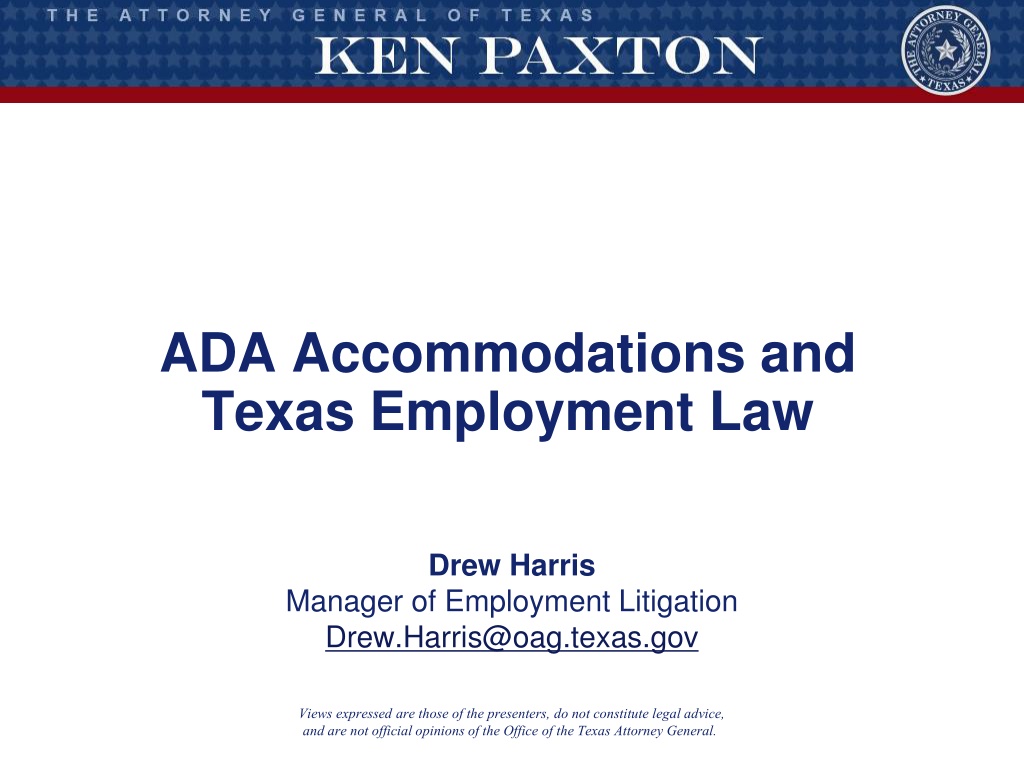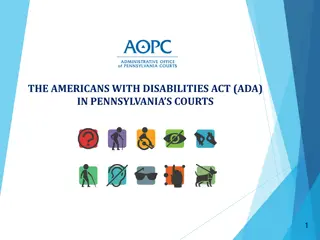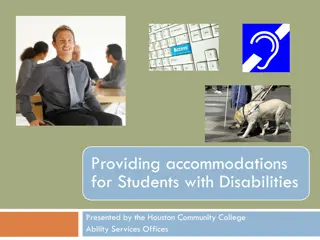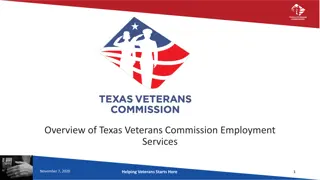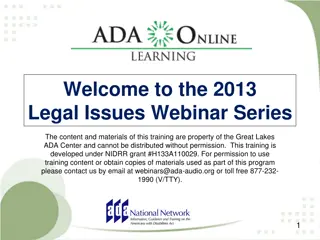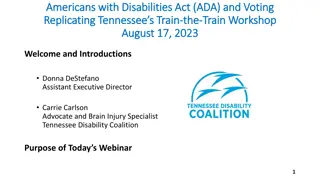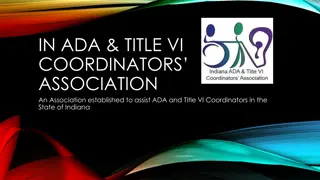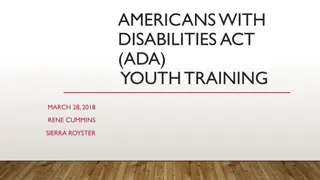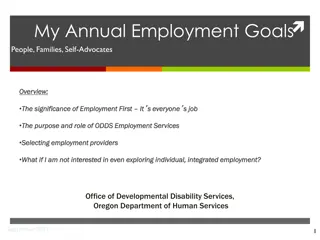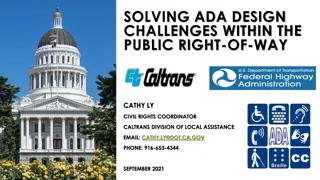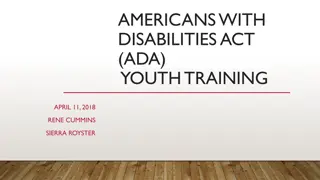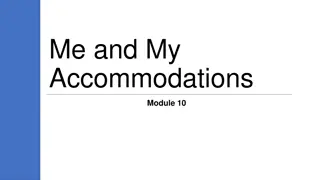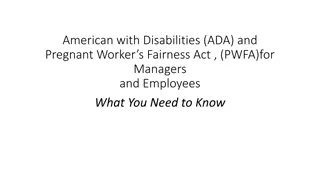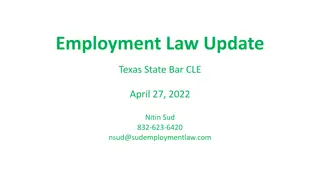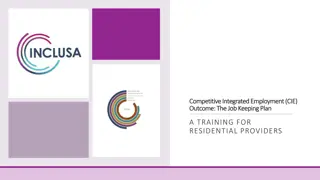ADA Accommodations and Texas Employment Law
Federal and state disability accommodation laws, types of resulting lawsuits, accommodation scenarios, practical tips, trends in EEOC charges, and laws affecting the employment context are discussed. The laws prohibit discrimination, protect qualified disabled employees, require reasonable accommodations, prevent adverse actions based on disability, and enforce lawsuits under the ADA, Rehab Act, or TCHRA.
Download Presentation

Please find below an Image/Link to download the presentation.
The content on the website is provided AS IS for your information and personal use only. It may not be sold, licensed, or shared on other websites without obtaining consent from the author. Download presentation by click this link. If you encounter any issues during the download, it is possible that the publisher has removed the file from their server.
E N D
Presentation Transcript
ADA Accommodations and Texas Employment Law Drew Harris Manager of Employment Litigation Drew.Harris@oag.texas.gov Views expressed are those of the presenters, do not constitute legal advice, and are not official opinions of the Office of the Texas Attorney General.
Roadmap Summarize federal and state disability accommodation law Overview of different types of resulting lawsuits Walk through accommodation scenarios Give practical tips
Trends in EEOC Charges and Lawsuits General perception - seeing more disability discrimination lawsuits (and more for mental disorders) EEOC statistics Disability discrimination charges increase 20.4% (2008) 32.2% (2018) Of those 2018 charges, 2,093 (8.5%) for anxiety disorder EEOC lawsuits: In FY 2018, EEOC filed 199 lawsuits, 42% of them alleged disability discrimination from EEOC Fiscal Year 2018 EEOC Enforcement and Litigation Data
Disability Law in Employment Context: The Lay of the Land Americans with Disabilities Act, Title I ( ADA ) Rehabilitation Act, Section 504 ( Rehab Act ) Similar to ADA except for sole cause standard Texas Commission on Human Rights Act ( TCHRA ) Codified in Chapter 21 of the Labor Code Americans with Disabilities Act Amendments Act of 2008 ( ADAAA )
Overly Simplified Overview Disability laws generally prohibit discrimination on the basis of disability in employment Protects otherwise qualified employees who are disabled or regarded as disabled ADAAA greatly expanded the scope Requires employers to engage in an interactive process to make reasonable accommodations (not necessarily the employee s preferred accommodation ) Prevents termination or other adverse employment actions based on disability discrimination Prevents termination or other retaliation for protected activity
Lawsuits to Enforce Disability Laws Failure to accommodate claims Hostile work environment claims Discriminatory termination claims (or other adverse employment actions ) Retaliatory termination claims (or other discouraging actions ) All these claims can be brought under the ADA, Rehab Act, or TCHRA
Administrative Remedies Exhaustion Requirements Both ADA and TCHRA require employees to file a Charge of Discrimination with an administrative agency Federal EEOC within 300 days State Texas Workforce Commission within 180 days Then timely file lawsuit after receiving Notice of Right to Sue Federal Within 90 days State Within 60 days But Rehab Act claims do not require remedies exhaustion
Big Change: ADAAA in 2008 Before ADAAA: Disability required an impairment that substantially limits activities of "central importance to daily life (e.g., walking) Courts imposed a strict interpretation of substantially limits After ADAAA: Substantially limits not meant to be a demanding standard Impairment that substantially limits at least one or more broad list of major life activities
Major Life Activities in Statute Caring for oneself Performing manual tasks Seeing, hearing, eating Sleeping, walking Standing, lifting Speaking Breathing Learning Concentrating Thinking Communicating Working Also operation of a major bodily function immune system functions normal cell growth digestive, bowel, bladder and neurological, respiratory, circulatory, endocrine, and reproductive functions
Example of Post-ADAA Change: Obesity Before ADAAA, several cases holding obesity is not a disability After ADAAA: Lowe v. American Eurocopter (N.D.Miss. 2010): These cases were all before the ADAAA took effect. This is especially important due to the expansion of what substantially limits and major life activities mean under the ADAAA . Here, Plaintiff asserts that her weight affects the major life activity of walking. EEOC v. Resources for Human Development, Inc. (E.D.La. 2011): The Court should recognize that severe obesity qualifies as a disability under the ADA and that there is no requirement to prove an underlying physiological basis.
Examples of Potential Disabilities Held to be disabilities Obesity Cancer Alcoholism Asthma Diabetes Sleep apnea High blood pressure Attention Deficit Disorder Anxiety Depression Held not disabilities Pregnancy Drug abuse (current) Being left-handed Personality traits Bad judgment General stress
Three Ways to be Disabled 1. Actually disabled: Have an impairment that substantially limits one or more major life activities 2. Record of impairment: Records indicate previously disabled Completed drug abuse rehabilitation program 3. Regarded as disabled: Employer mistakenly perceives a disability (regardless of actual impairment or effect of that impairment)
Who Starts the Interactive Process? Scenario: Blitzen the reindeer is bumping into things. Santa suspects he is mentally impaired (or perhaps just needing glasses)? General rule: Employee s duty to ask for an accommodation to start interactive process Can be plain English request Best practice: have a designated ADA accommodation process with a trained HR person Caveat: Very obvious disabilities, and EEOC Guidance says if employer knows: 1) employee has disability, 2) with resulting workplace problems, and 3) disability prevents requesting accommodation then employer should start interactive process
Continuing the Interactive Process Scenario: Blitzen s preferred accommodation is not driving at night. Santa says this is not reasonable. Blitzen refuses to provide any medical info, and threatens to quit. Next step? Supposed to be an informal, flexible process arriving at a reasonable accommodation Employee breaks the interactive process by refusing to cooperate or leaving Employer breaks the interactive process by ignoring requests or terminating
Extended Leave as an Accommodation Scenario: Frosty has been on FMLA leave since June, and has exhausted all available leave by September, but has a doctor s note saying he can return to work in December. Reasonable accommodation? Case-by-case decision: Burden on employer Amount of leave already given (cases finding over a year not reasonable) Clear rule: Indefinite leave of absence is not reasonable (vague doctor s notes, requests to return as soon as he is able to )
Accommodation for Anxiety? Scenario: Buddy the Elf is diagnosed with anxiety disorder. He feels like Santa is too harsh on him, and requests that Santa cease his hostile confrontations with him and provide him with fair, non-confrontational treatment. Response? Hargett v. Florida Atlantic University: Granted summary judgment, holding employee cannot immunize himself from stress. But if employee could pinpoint particular stressors (like shouting), potentially need to accommodate
Litigation Defense Strategy: Qualified Whether employee can perform the essential functions of the job with or without an accommodation Look to job description (one of many factors) Dealing with stressful situations or providing excellent customer service as an essential function in job description Not qualified if an individual (even with an accommodation) poses a direct threat to the health or safety of others Individualized determination needed EEOC v. Old Dominion Freight Line (W.D. Ark. 2013): unlawful policy of excluding alcoholics from truck driving position without individualized determination
Defending Against Hostile Work Environment Claims High standard from Title VII for showing a hostile work environment Need to show workplace was permeated with discriminatory intimidation, ridicule, and insult that is sufficiently severe or pervasive to alter the conditions of the victim s employment Stray remarks not enough Need to show harassing conduct was due to disability Lenzen v. Workers Compensation Reinsurance Association (8th Cir. 2013): disabled employee berated for low job performance failed to show an environment hostile because of her disability
Defending Against Wrongful Termination Claims McDonnell Douglas v. Green burden shifting framework Prima facie case: 1) employee is disabled, 2) is qualified, and 3) was terminated because of disability (or because of protected activity) Employer then has burden of production of a legitimate non- discriminatory reason for termination Employee then has the ultimate burden to prove the stated reason is mere pretext for discrimination Different causation standards: motivating factor vs. but-for vs. sole-cause (Rehab Act)
Practical Tips Have clear job descriptions with essential functions Do not assume/treat employees as disabled unless they disclose their disability If an employee requests an accommodation, engage and be patient in the interactive process Have a trained HR person handle accommodation requests rather than individual supervisors If litigation seems likely, put together a timeline of key events Retaliation claims are much harder to defend than discrimination claims
Thanks for Listening! Any questions? Feel free to email me for these slides Drew.Harris@oag.texas.gov
